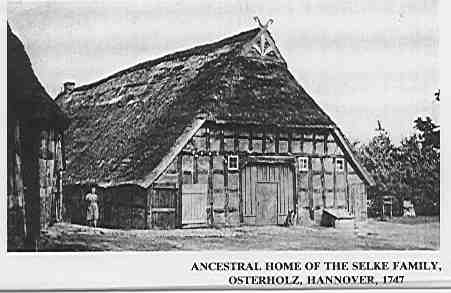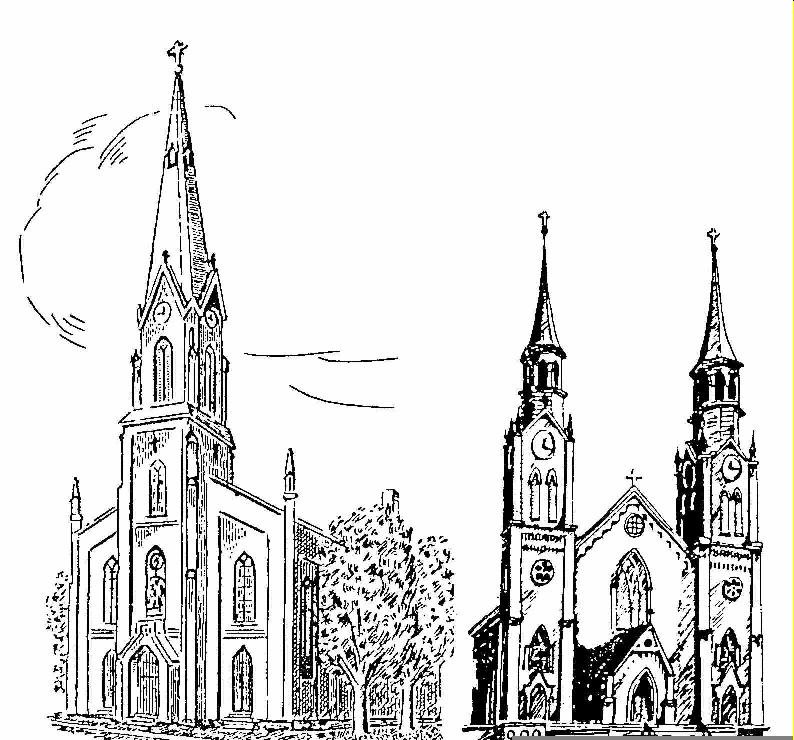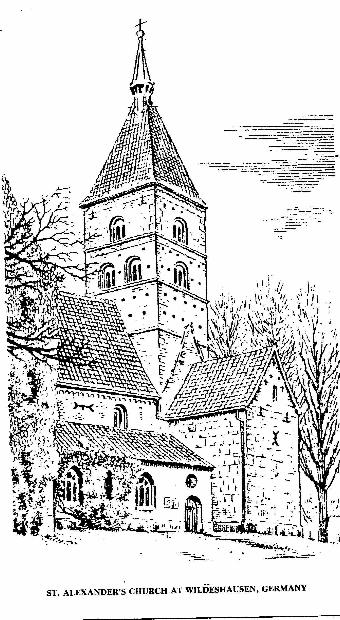
CHAPTER 5
RELATING TO OUR IMMIGRANT PAST

CHAPTER 5
RELATING TO OUR IMMIGRANT PAST
There has been a recent interest in uncovering the Germanroots and preserving the German heritage of the state of Indiana. A German renaissance is occurring in Indiana, particularly due to the Tricentennialof German immigration to this country: 1683 - 1983. The area aroundBatesville has an important contribution to make to that revival of interest.
What has been sketched in the preceding chapters aboutthe history and culture of northern Germany can also be written in a differentway about the history of other areas from which immigrants came. The immigrant past is unique and varied for each family. There isa significant Swiss settlement in this area with names like Abplanalp andAbegglen with a different story to tell. The Bigney family came tothis area after several generations in Nova Scotia, having originally leftMontbeliard near the Swiss border in France.
Alsatian families like the Brickas of Woerth, the Wolljungsof Geisweiler, and the Menchhofers of Kirchweiler spoke German, but wereunder French rule from 1681 until they immigrated to America. TheNeufarth family came from Hohensulzen near Woerms in HesseDarmstadt witha family tradition that they were ethnically Jewish although they appearedin the Lutheran churchbooks in Hohensulzen beginning in 1749.
The Hillenbrand family came from Frankenthal in the Palatinateor Rhein Pfalz. They listed their homeland as Bavaria because thePalatinate was ruled by Bavaria after 1777. The Huber and Baas familiesemigrated from Obersimten and Winzeln near Pirmasens in the southern partof the Palatinate. The Palatinate was the source of much immigrationto America through the years.
Some families in this vicinity, like the descendants ofRev. Daniel Palmer, an early Baptist minister, can trace their ancestorsback to New England immigrants who were buried in this country before thefirst Germans came over 300 years ago. The tapestry of immigrationto this area is rich in history and culture.
ETHNIC PAST BURIED BY DOMINANT CULTURE
The lack of a sense of place has long contributed to Americanrootlessness. In today's media culture, a sense of place is becominga thing of the past. For example, most of the forefathers of thepeople in this area did not sail into New York harbor under the Statueof Liberty. It didn't exist when they came over, and more likelythey came through the ports of Philadelphia, Baltimore, Charleston, andNew Orleans. These events have been forgotten and need to be rediscoveredto help people relate not only to their own unique past, but to the Statueof Liberty as well.
The Statue of Liberty is a symbol, but it is a symbolwhich many Americans have difficulty relating to because the immigrationof their ancestors is no longer a part of their sense of who they are. Unfortunately, most immigrant groups have not been very successful in preservingtheir diverse ethnic origins and traditions in this country.
Citizens of the United States have long been familiarwith the history of the English-speaking peoples. Recently, we havebeen made more aware of the history of other ethnic groups. The televisionseries "Roots" was such a powerful tale because it uncovered a family historywhich had been so deeply buried by American culture.
The German heritage is also deeply buried owing in partto two World Wars with Germany, the domination of the English language,and the necessity of emphasizing the English and French origins of thepolitical ideas in this country. Consequently, despite a huge Germanimmigration, many people of German descent are not particularly aware oftheir German origins and heritage.
This lack of awareness is particularly true of the heritageof northern Germany where many of the families of the Batesville vicinityoriginated. The Germany most frequently portrayed for tourists isthe Black Forest in Baden, the Alpine regions of Bavaria, and the Rhinewith its castles.
Much of the work in identifying the north German culturein Indiana has just begun. One such example is "Brought, Borrowed,or Bought" by Gary Stanton, a folklorist who wrote his doctoral dissertationon the material culture brought from Germany to Ray and Butler townshipsin Franklin County. Copies are in the Batesville and Brookville publiclibraries.
County and local histories for the most part neglectedto record precise origins. For many years those origins were obviousand well known. Later they were ignored or forgotten. Todayregional origins may be found in the census or sometimes in county historiesand atlases. However, specific villages can usually be found onlyin church records, family papers and histories, U.S. immigration and naturalizationrecords, or by long and difficult searches through emigration records inGermany.
REDISCOVERY OF GERMAN ORIGINS
In 1978 and 1979, Richard Theilig, a German immigrant,translated the Adams Churchbook from old German "handschrift" into typedEnglish. Before that time, many Adams Church families did not knowthe names of the villages where their ancestors came from in Germany. Now we can pinpoint the exact location of the village of origin of some150 immigrants to Adams Township. That churchbook revealed that manyhad come from the single village of Wachendorf and attended church at Heiligenfeldeone mile away.
Likewise, Mr. Theilig's translation of the Huntersvillechurchbook reveals that many families in the Batesville area came fromthe EngterBramsche-Venne vicinity just north of Osnabrueck. The Hubble'schurchbook reveals a variety of places of origin for the families of thatchurch. Other churchbooks remain to be examined, translated, andstudied for more information.
RE-ESTABLISHING LINKS WITH GERMANY
As a result of the translation of the churchbooks, contactsare being re-established with communities in Germany. In 1985, 1traveled to Heiligenfelde, Germany, presented a copy of the Adams Churchbookto the Pastor, and gave an interview to the local German newspaper aboutthe origins of Ripley County immigrants in the WachendorfHeiligenfeldearea. I tried to meet relatives of several Adams Church familiesand returned copies of letters to one lady that had been written by hergreat aunt 75 years earlier. She in turn gave me a photograph ofSophie Rohls at her home south of Sunman.
I also traveled to Engter, the home of some early Huntersvillefamilies, to find my own third cousins, the Dreyers, still living on theold homestead built by my great-great-grandfather. Our families hadnot communicated for 75 years, yet we both had photographs of each other'sgrandparents taken at the turn of the century.
In 1986, Professor Antonius Holtmann of the EmigrationInstitute at the University of Oldenburg, Germany, came to visit both Oldenburgand Huntersville, Indiana, for a large-scale project evaluating Germanletters, documents, and church records. He too is interested in linkingthe communities and families on both sides of the Atlantic. DetlefGoldmann of Heiligenfelde whom I met on my visit to Germany also came tovisit Adams Church in November of 1986.
Phyllis Bergman Rhodes, a descendant of the Behlmer andSelke families, recently traveled to the Heiligenfelde-Barien area to meether 4th cousins, the Segelkes. Keith Selke of Indianapolis had providedthe research which re-established these family ties. A few familiesmay have maintained some contact with their roots in Germany through theyears since immigration.
This is potentially just the beginning of further communication,information, and exchanges for both sides of the Atlantic. We havemuch in common, and have had over a long period of time.
IDENTIFYING THE IMMIGRANT CULTURE
Some of the oldest human questions are "Who are we?" "Wheredid we come from?" "Why do we behave as we do? " "Where did we getour ideas?" Partial answers to these questions are to be found in the homelandsof our ancestors.
There are places and communities back in Germany and elsewherewhere our forefathers lived that still exist. Although times havechanged, they still eat some of the same food our forefathers ate, livein the old ancestral homes modified from the original barn-houses, useand cherish some of the old furniture, cultivate their fields meticulously,and plant flowers everywhere. Some still even intermarry among thesame families that have also intermarried over here.
Today, the standard of living in Germany is much likeour own. Immigration has virtually ceased. The years of conflictare beginning to fade from living memory. The people of those communitieswould also like to know more about the descendants of those who left Germanyin hopes of finding something better. They certainly must wonderhow our lives are different from theirs as a result.
SHARING INFORMATION ABOUT OUR PAST
BOTH HERE AND ABROAD
During this sesquicentennial year for Huntersville, Oldenburg,and Penntown, Batesville area residents can research their own immigrantorigins and try to make contacts with churches, families, and towns backin Germany and elsewhere. The celebration this year is not limitedto a particular group, but it is a celebration of, and for, the entireBatesville-Oldenburg-Penntown vicinity.
Furthermore, the groups which left Damme, Venne and Heiligenfeldedid not just come to Oldenburg, Huntersville and Adams Church. Protestantfamilies from the vicinity of Venne also settled in Jackson and Bartholomewcounties as an examination of churchbooks at Borcher's, Sauer's and WhiteCreek Lutheran Churches near Seymour and Columbus will reveal. Catholicfamilies from the Damme vicinity not only settled Oldenburg, Indiana, butalso Minster, Ohio.
Much more research is needed, not only into the originsof northern and southern Germans who came to this area, but also into theorigins of the early English, New Englanders, and Pennsylvanians who camehere over 150 years ago, and the settlers of Irish descent who have continuedto arrive from the south and elsewhere. Your county's historicalsociety can often help you get started.
The Batesville Public Library is seeking materials forits family History section. Presently, the library has family historiesof the Sarringhaus, Selke, Hickman, Bauman, and Kassens families, amongothers.. The Ripley County Historical Society and the Osgood Public Libraryhave many more. Each of these histories adds to our understandingof the origins of Batesville area families.
There is a vast quantity of old letters, obituaries andremembrance cards in this vicinity, often found in attics, family Biblesand "places for safe-keeping". They need to be copied, translatedand made available to others. The Batesville Public Library is thelogical repository for copies of these materials, family trees and writtenhistories of families in Laughery, Adams and Ray townships, as well asthe surrounding area. Your contribution of copies of these materialsto the library is encouraged.
The celebrations of the sesquicentennials of Oldenburgon July 2, 3 and 4 and Huntersville on July 24, 25 and 26 are importantmilestones. It is hoped that in the future more visits and exchangeswill take place both here and abroad. Some members of Huntersvillechurch will be joining others from Jackson and Bartholomew counties inmaking the trip to Venne for their 900th anniversary celebration on August20 - 23.
Through these events and activities the long lost tieswith the ancestral origins of the Batesville area communities will graduallybe reestablished.
If you would like more information about the immigration,please write to David S. Dreyer, 5725 Winston Drive, Indianapolis, Indiana 46226

